Last-Minute NYC Holiday Gift Guide 🎁
We’ve created a holiday gift guide with presents for the intrepid New Yorker that should arrive just in time—

A few weeks ago I attended a screening of the new movie My Brooklyn at the Lafayette Avenue Presbyterian Church (LAPC) in Fort Greene. This strongly built Romanesque Revival church stands at the corner of South Oxford and Lafayette and is part of the Fort Greene Historic District. Immediately upon entering the main hall, I was struck by a mural that wrapped around the upper balcony. While so many churches have beautiful stained glass windows and large art depicting religious icons, this mural unassumingly displays completely normal people, wearing bell bottom pants, jeans and suits. The movie screening in its own right sparked considerable discussion, but I left the church with the need to know more about the mural I had just seen.
After reaching out to the church for more information, they put me in touch with Ed Moran, a longtime church member who was able to give me background history on the mural and the church. Moran told me that the Lafayette Avenue Presbyterian Church was completed in 1862 by the architecture firm of Grimshaw and Morrill. Romanesque-Revival was a popular form for urban churches during this period, and was perfect for Presbyterians who didn’t need pomp, gothic details and ceremonial space like Roman Catholics. The Pastor at the time was a man named Rev. Theodore Cuyler, known for his dynamic personality and his fierce abolitionist views. A strong Unionist, his editorials in the New York Independent denouncing slavery were cut out and collected by President Lincoln. Rev. Cuyler and the church made national headlines in later years after allowing the first female, a Quaker no less, to preside as preacher over a Presbyterian service in the United States.
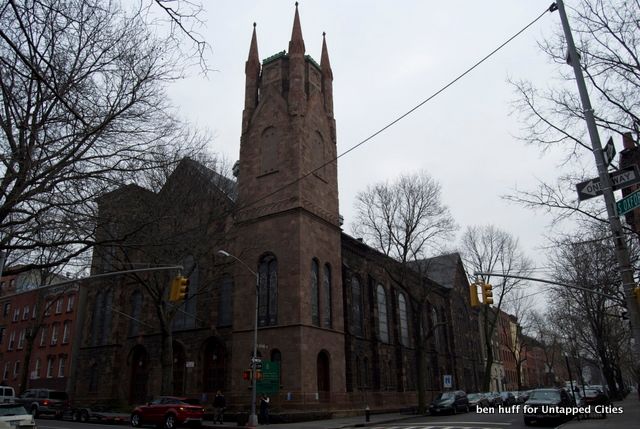
LAPC also connected me with the artist; Hank Prussing. Through a phone interview, Prussing told me his own story and how he came to paint it. Originally from Maryland, Prussing joined the LAPC church choir after moving to New York to attend the Pratt Institute. Prussing’s father, a choir director had actually known LAPC’s pastor at the time, Rev. George Knight, an organist and the two connected through music. Previously, Prussing painted a mural at his hometown church, New York Avenue Presbyterian Church (Lincoln’s preferred D.C. church), and after Rev. Knight saw photos in a magazine, he asked him to work on another at LAPC.
The walls of LAPC, originally plain, had been covered in maroon-colored decorative stencil work in the 1890s, designed by Louis Comfort Tiffany to enhance his 10 stained-glass windows in the sanctuary. The walls were returned to their original plain state after renovations in the early 1960s. Long time church member Elise Woodward Stutzer, a daughter of a wealthy watchmaking family, left in her will money to fix the walls or restore them to their original glory. Rev. Knight and Mr. Prussing realized that this was an opportunity, and decided to use the funds to create a mural that would reflect the diversity that Fort Greene now had.
Prussing’s own work in East Harlem served as inspiration, titled The Spirit of East Harlem, a mural which depicts many longtime Puerto Rican residents, and employed the same methodology to create his new work (see a story on that here). He set out with his camera and captured images of people from the church’s neighborhood which he then developed in a dark room at Pratt. He took hundreds of photographs, hundreds more than would eventually be included on the final painting. He also researched many of the documents the church had, and the symbols contained in the Tiffany windows along the upper balcony. Using self-selected photos, he sketched out the portraits on a piece of paper, accounting for the various windows and doors within the church. After presenting the plan to a church committee, which happily accepted the proposal, Rev. Knight settled on the title Mighty Cloud of Witnesses, based on a phrase in a letter to the Hebrews.
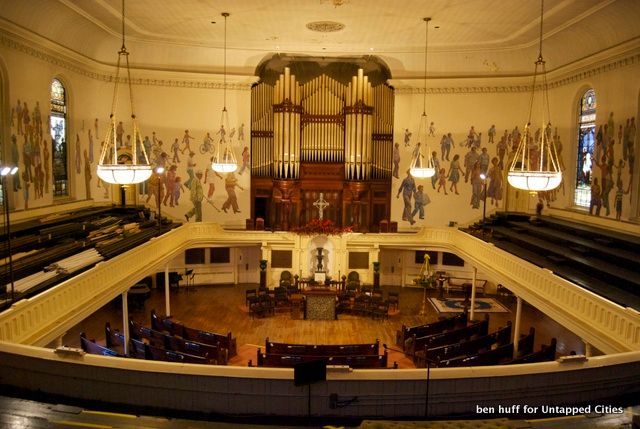
After finishing his architecture degree from Pratt in 1975, Prussing began work in June without a definitive time frame; which led to a three year on and off project in where he set up his scaffolding, sketched scenes and painted. His artist-in-residence style, which Prussing felt was very “renaissance” in nature was good for both the church members and the artist, both enjoying the relationship.
The mural starts with the Austin Organ, an enormous instrument that splits the entire church in half. The organ represents sound, and is meant to come before the beginning and after the end of the mural. The mural begins on the right side, with people “arriving” and then wraps around the church, following the curved walls. The story told within the Tiffany glass windows follows this same path, beginning with Christ’s Birth, moving along to Death and finally Resurrection on the opposite side. Prussing found that a special sermon was given at the time each window was installed, and the mural fills in the spaces between to “reconnect” them. As the mural is completed on the eastern side, the people get subtly smaller as they complete the swirl back to the organ.
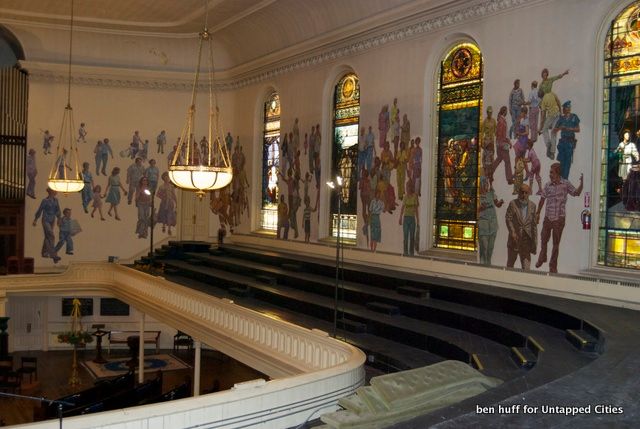
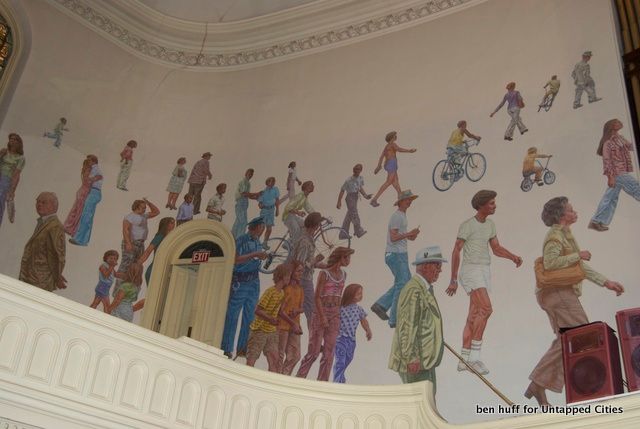
Originally the only opponents of the mural were those who feared they would detract from the stained glass windows. Prussing counters he actually tried to support them with the types of scenes he painted around them, reflecting the universal themes that are projected by the images in the windows, and even matching colors in the portraits to the colors in the glass.
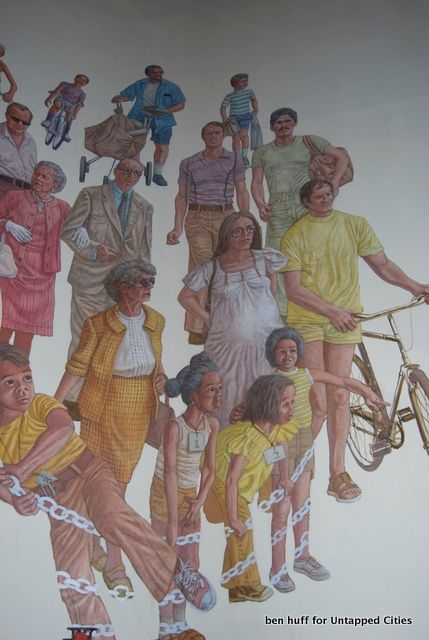
When I photographed the mural with Mr. Moran’s assistance, I was joined by a fellow church member. Cie Shepperson came to the church in the mid ’80s, almost a decade after the mural had been completed. She came with a friend because she heard they had good music at their services, and she was looking for a new church. Upon entering the hall she noticed the mural, and was quite fascinated by it. She nearly lost her breath however after recognizing a few people. On top of the section painted between the second and third window is the back of a women wearing a bright floral dress and reaching down to a young girl.
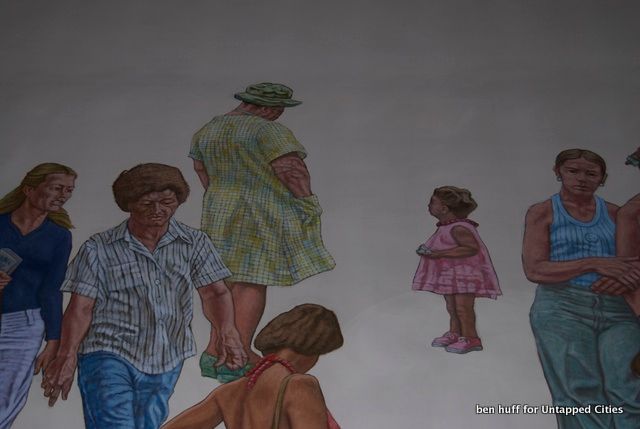
Mrs. Shepperson immediately recognized the two women as her mother and grandniece, and she showed me photos of her mother, who was part Native American, to show the similarities. The fact that her mother is wearing another floral dress in the photo seems to further support this connection. Continuing to inspect the mural, she found two people in the corner that she believes are herself and cousin, both sporting a hairstyle popular at the time the photographs were taken.
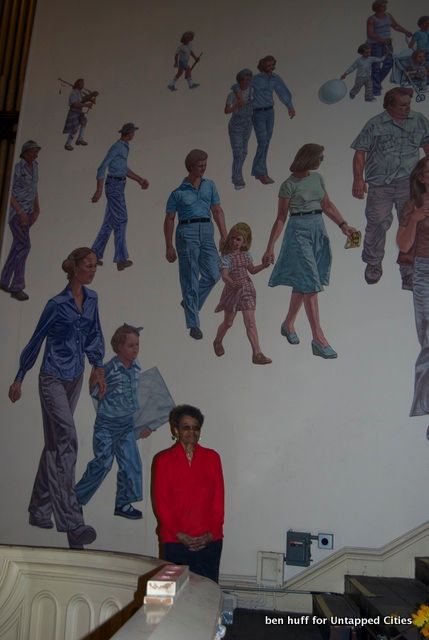
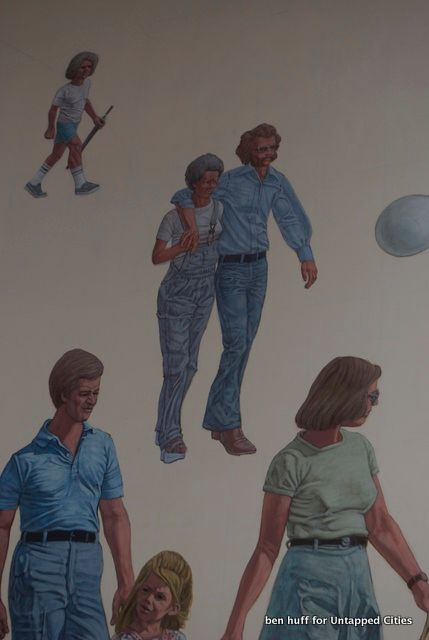
Mrs. Shepperson’s story is an amazing one. Her father moved with his new wife to Brooklyn to become a driller at the Navy Yard. She fondly remembers attending Girls High School in her neighborhood of Bedford Stuyvesant, and spending summers at Camp Sebago upstate learning archery and hiking. She then went on to attend NYU for both her bachelors and masters in education, eventually becoming a principal in the New York Public School system. It was a pleasure hearing her story, and she shared many photos, snippets of a life fully lived, almost entirely within the Borough of Brooklyn.
As I toured the mural with Mrs. Shepperson and Mr. Moran they both were able to point out people they remembered and little stories about them. Later, when I asked Mr. Prussing if he ever documented exactly those depicted in the mural were he explained that he did not, his desire to keep them anonymous even highlighted by simplifying facial features to make them more generic when painting. This is the main distinction between The Spirit of East Harlem and Mighty Cloud of Witnesses.
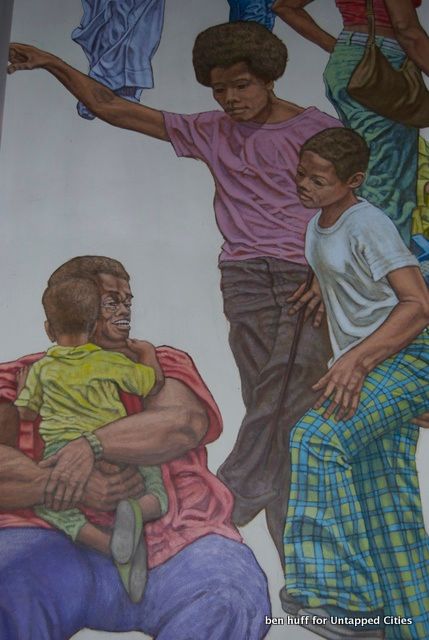
I spent this afternoon with Cie, but stepping back and gazing up I wondered how long it would take to hear the stories of the over 100 souls adorning the white walls. Prussing explains, “What I was trying to create was different than most murals. Windows, in architecture terms, are normally meant for looking outside while walls are not. But in a church, the stained glass windows encourage you to look within, for reflection. I used the mural to create a street scene on the wall, so to gaze on these spaces between the windows it’s as if you are actually looking outside on to the streets of Fort Greene.” He also explained that the name he had wanted for the mural was actually Clouds of Witness, not the Mighty Cloud of Witnesses the church uses.
Prussing now works as an architect in Connecticut, a job that keeps him quite busy and unable to pursue art as much as he would like. During his time in New York, Prussing painted 35 murals throughout the city. But as New Yorkers know, this city is always changing, and many have faded or been lost to tragedy, like a mural he completed at the World Trade Center. That’s what makes this particular mural quite special; it is indoors which keeps it safe from the weather, but also out of the public eye. (As we say here, it needed to be “Untapped”!)
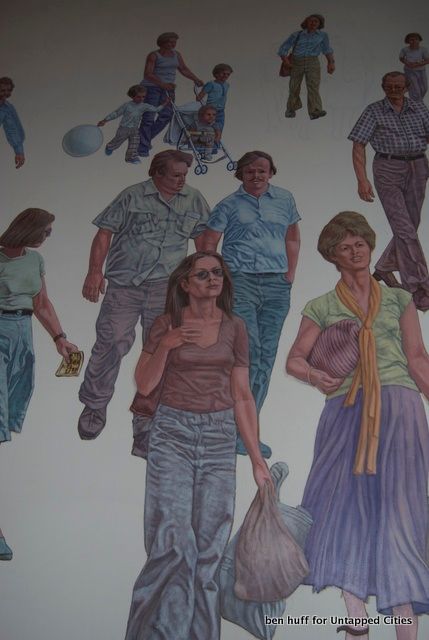
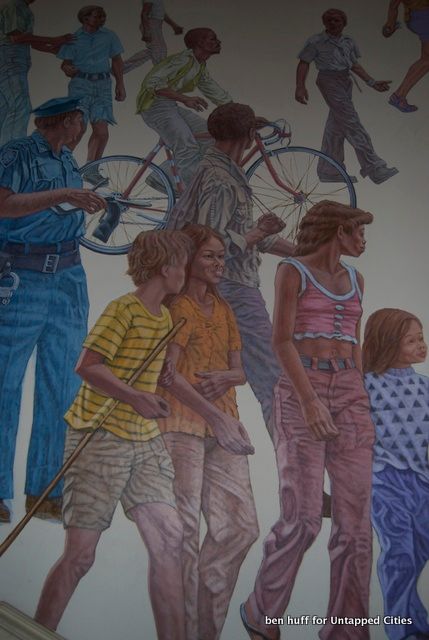
As I write this article almost 40 years after the mural’s completion, the neighborhood of Fort Greene, despite being landmarked, has changed significantly. Even the documentary that I came to the church to see lamented how much the neighborhood, especially nearby Fulton Mall, has changed to reflect new demographics and increasingly upper class residents that now inhabit the tree-lined brownstones. But this mural is a snapshot of the working class era of Fort Greene, and a testament to the people who sustained it for decades. To gaze upon it is to witness Cie Shepperson’s Fort Greene of 1975. A street scene of a typical hot, summer day, kids playing, people walking home from work, and police walking the beat. In the silence of the church you can almost hear them speak.
Subscribe to our newsletter